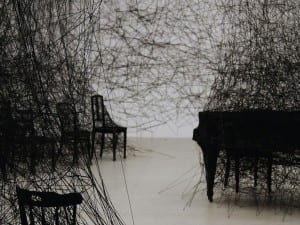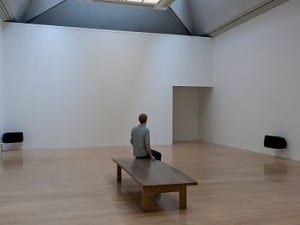As part of the University of the Arts London, the Chelsea College of Art & Design graduate show runs for one more day. Featuring pieces from those graduating in Fine Art, Graphic Design Communication, Interior and Spatial Design and Textile Design, some of the graduates have already been identified by the arts world at large. Sculptor and inventor Mimi Winsor has been commissioned by the Discovery Channel to create an installation piece for its head quarters in Chiswick, London and Aesthetica speaks to her about the way she views her work and winning The Oval House Award.
A: Some people would argue that to be an artist you don’t need to go to university, as a graduate what do you say to that?
MW: You can be an artist without going to art school, however I have greatly appreciated being a part of the artistic community at my college. The conversations with other students and mentoring from tutors has greatly influenced and re-enforced my practice. The type of work I engage in requires studio time for its evolution. Vitally important has been access to the excellently equipped workshops at Chelsea where I have been keenly supported by enthusiastic technical staff in learning new processes such as welding. Working alongside like-minded individuals means I am graduating with a group of practitioners and a band of great friends. We will be emerging into the art world together.
A: You are a sculptor and refer to yourself as an “inventor”, do you think the two are inseparable or quite different?
MW: As an artist you are always inventing. You try to expand the boundaries of human knowledge and experience. An artist has to challenge approaches to the way people see and think. In my own practice, the process based sculptures I create are physical explorations themselves. In that sense I am always investigating material. I invent and generate machines, which not only explore the substances’ mass and materiality but which present a highly physical encounter for the viewer. My final show exhibits machines that squeeze, pinch, stretch, roll, dollop and extrude over half a tonne of play-dough.
A: Within your work you examine childhood, how do you translate that into a sculptural form?
MW: In generating work I try to take a fresh look at something we take for granted or a material that is common place in our lives. The pieces are invented to explore the senses of touch, texture, smell, colour and sound as well as subjective memory.
I’m particularly influenced by the psychoanalyst, Melanie Klein, and her idea that things can be best understood through physical experience. I try to engage with this concept when inventing the machines. But it’s not all serious psychological stuff, there is a large dollop of humour too created as a bi-product from the fact that the installation is seemingly purposeful and functional on the surface, yet absurd and ridiculous in the ingeniously playful way things are created. The unpredictable nature of what may happen during the performance due to the consistency of the dough means that it can be a rather comical happening.
A: Which artists have inspired you?
MW: There are many artists who inspire me but to name a few:
Lygia Clark, who created multi sensory experiences where the spectator became the participant through “living” the experience. She examined the role of sensory perception believing that through physical stimulation her relational objects could unlock memories trapped inside the body at a preverbal level that language alone could not touch.
Chris Burden’s When Robots Rule: The Two Minute Airplane Factory interests me because he designed a machine that failed to work despite many efforts from specialists to get it going. This stimulated many to question if the work was a failure or if what was actually presented as a result made the work more interesting. In my practice there is a similar exploration of unpredictability and questioning of what is failure? The work itself takes on its own character and life, escalating from the beginning within the space. My work being a physical experiment means that every investigation is valid no matter how messy and chaotic it may get.
Kate Gilmore, who challenges herself to absurd acts that explore her own physicality and often involve testing her strength in a struggle. She dresses in feminine attire that exacerbates the difficulties of the strenuous messy and chaotic activities she undertakes creating an absurd humour in the fact that she is doomed to fail. Her work demonstrates a playful creative destruction and I particularly like her piece titled ‘Cake Walk’ where she wears a pair of roller skates and tries to climb up a precarious steep wooden ramp to reach a chocolate cake at the top.
A: What do you plan to do next?
MW: I aim to get a studio in London next year with fellow graduates from Chelsea and continue my practice as working up to the degree show I have a lot of new ideas to now explore. I have a number of projects in the pipeline including a commission for Discovery Television later this month. At the end of the summer I am building a Giant Tree Top Marble Run for the End of the Road Festival.
I have also won The Oval House Award at my degree show meaning that I get to put on a theatrical installation shown at the renowned South London Theatre. I’m excited as being housed in a theatre means I can further explore the audience’s active involvement in the work, possibly making the devices open for operation by the public.
The installation I will build takes its inspiration from the old Peek Freans biscuit factory, which was located in Bermondsey. Filmmakers’ Cricks and Sharp’s documentary showing the factory’s working day will be a key inspiration for the show. This film shows the mechanical contraptions used to mix, roll, cut, and bake the biscuit dough. The mechanical automatons are set amidst a whirl of factory workers who hurl sacks of flour, mountains of butter, shovels of sugar and finally trays of biscuits around in a seemingly chaotic choreographed dance.
Credits
1. Mimi Winsor, Squeeze, Pinch, Stretch, Roll, Dollop and Extrude.





